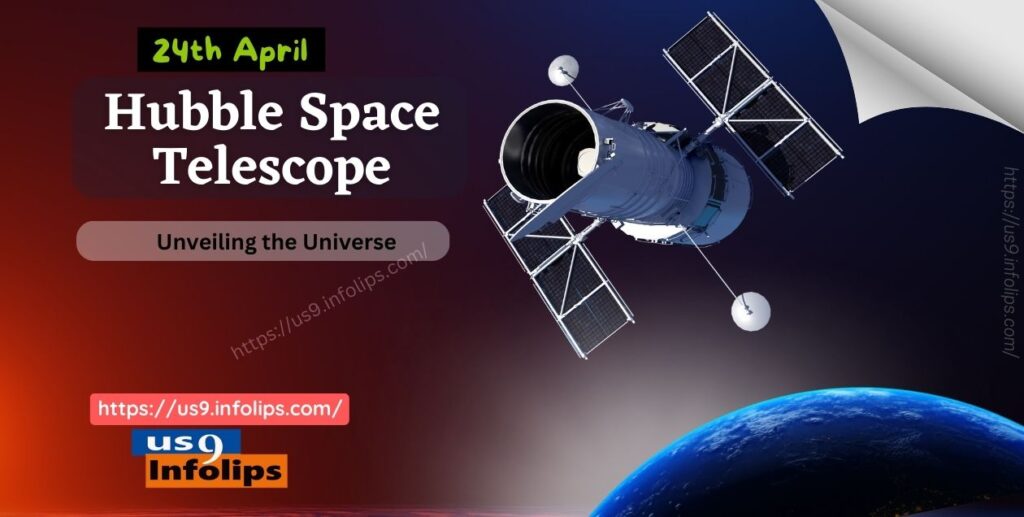Hubble Space Telescope : The Journey of the Hubble Space Telescope | Best Info by Infolips #1
Hubble Space Telescope: Unveiling the Universe Through a Cosmic Eye | Hubble Space Telescope Anniversary Day
Intro:
Launched into Earth’s orbit in 1990, the Hubble Space Telescope has revolutionized our understanding of the universe. Orbiting far above atmospheric distortion, it captures breathtaking images of distant galaxies, nebulae, and cosmic events with unprecedented clarity.
More than just a scientific instrument, Hubble is a symbol of human imagination, determination, and the quest to understand the cosmos.
Table of Contents
The Journey of the Hubble Space Telescope
1. The Dream Begins (1940s-1970s):
Astronomers long envisioned a space telescope free from atmospheric distortion. The idea gained traction post-WWII as technology evolved, setting the foundation for Hubble.
Astronomer Lyman Spitzer proposed the idea of a space telescope to avoid Earth’s atmospheric distortions. NASA and ESA collaborated to bring Hubble to life.
2. Planning and Approval (1977):
NASA and ESA joined hands for the ambitious project. After decades of research and advocacy, Hubble was approved and funding secured in 1977.
3. Design and Construction (1978–1985):
Engineers built a 2.4-meter primary mirror and state-of-the-art scientific instruments. Its creation involved intricate optics, gyroscopes, and a sun shield.
It built with dvanced cameras, and spectrographs to observe ultraviolet, visible, and near-infrared light.
4. Launch Delays and the Challenger Disaster (1986):
Originally set for 1986, Hubble’s launch was postponed after the Challenger disaster. Safety measures and redesigns pushed the launch to 1990.
5. The Grand Launch (April 24, 1990):
Deployed from the Space Shuttle Discovery (STS-31), Hubble reached low Earth orbit, sparking global excitement among scientists and space enthusiasts.
6. A Flawed Beginning (1990):
Soon after launch, Hubble’s images appeared blurry due to a spherical aberration in its main mirror—a major blow to NASA’s reputation.
7. The Heroic Repair (1993):
Astronauts aboard the Space Shuttle Endeavour (STS-61) performed a daring servicing mission, installing COSTAR corrective optics. Hubble’s vision was restored.
8. Golden Era of Discovery (1994–2020):
Hubble Space Telescope:
With clear sight, Hubble captured iconic images like the Pillars of Creation, discovered dark energy’s effect on the universe’s expansion. The Hubble Deep Field, and stunning galaxy collisions, reshaping astronomy.
Astronauts upgraded Hubble five times, adding advanced cameras like ACS and WFC3, extending its lifespan.
Hubble helped measure the universe’s expansion rate, confirmed black holes, and studied exoplanet atmospheres.
Surpassing Expectations – Designed for 15 years, Hubble remains operational for over 30, thanks to repairs and upgrades.
Challenges in Orbit – Gyroscope failures, aging systems, and software issues have threatened operations, but engineers found innovative fixes.
Legacy and Continued Impact (2025–Present):
Despite the launch of the James Webb Space Telescope, Hubble remains active. Its collaboration with JWST and other telescopes continues to shape modern astronomy.
9. Challenges in Aging (Ongoing):
Hubble Space Telescope has faced gyroscope failures, software issues, and power glitches, yet with remote fixes and NASA support, it still gazes into the unknown.
9 Major Discoveries by Hubble
- Accelerating Universe & Dark Energy (1998) – Hubble helped prove the universe’s expansion is speeding up.
- Hubble Deep Field (1995) – Revealed thousands of galaxies in a tiny patch of sky.
- Pluto’s Moons (2005, 2011, 2012) – Discovered Hydra, Nix, Kerberos, and Styx.
- Exoplanet Atmospheres (2001 onwards) – First direct detection of an exoplanet’s atmospheric composition.
- Black Hole Confirmations (1994 onwards) – Provided evidence of supermassive black holes in galaxy centers.
- Age of the Universe (2013) – Refined estimates to ~13.8 billion years.
- Pillars of Creation (1995, 2014) – Iconic Eagle Nebula image showing star formation.
- Galaxy Evolution (2000s) – Tracked how galaxies merge and evolve over time.
- Dark Matter Mapping (2007) – Helped map dark matter distribution using gravitational lensing.
9 Memorable Moments on Hubble’s Anniversary Day
- 2000: Released stunning images of the Eagle Nebula.
- 2005: Captured comet Tempel 1’s collision.
- 2010: Celebrated 20 years with a special gallery.
- 2015: Revealed a new “Pillars of Creation” shot.
- 2018: Showcased the Lagoon Nebula in vivid detail.
- 2020: Shared deep field views of distant galaxies.
- 2021: Highlighted galaxy cluster Abell 370.
- 2022: Presented star-forming region Westerlund 2.
- 2023: Released panoramic starfield of the Carina Nebula.
9 Aims Yet to Be Achieved to Hubble Space Telescope
- Capture direct images of Earth-like exoplanets.
- Determine dark energy’s origin with precision.
- Observe the very first galaxies post-Big Bang.
- Provide long-term data on stellar life cycles.
- Help locate possible habitable moons.
- Study the structure of intergalactic gas clouds.
- Refine models of cosmic inflation.
- Measure black hole spin in distant galaxies.
- Collaborate on gravitational wave follow-ups.
Other Key Points on Hubble Space Telescope
- Technological Spin-offs:
Technologies developed for Hubble, particularly in optics and detectors, have found applications on Earth, including in medical imaging (like digital mammography systems) and manufacturing processes. - Advancing Human Spaceflight:
The five servicing missions were critical in developing and refining techniques for astronauts working in space (Extravehicular Activities – EVAs), benefiting the International Space Station program and future exploration endeavors. - A Rich Data Archive:
All of Hubble’s data is publicly archived, creating an invaluable resource used by astronomers worldwide, ensuring its scientific impact continues long after its operational life ends. - Cultural Impact:
Hubble’s images have permeated popular culture, appearing in movies, art, music, and everyday items, profoundly shaping how humanity visualizes the cosmos.
Conclusion
The Hubble Space Telescope stands as a milestone in human achievement—a blend of science, vision, and resilience. From flawed beginnings to cosmic revelations, Hubble’s journey mirrors our own: imperfect, persistent, and full of wonder. As it nears its twilight years, Hubble continues to inspire new generations to look up, question more, and imagine the impossible.
FAQs on Hubble Space Telescope
- What is the Hubble Space Telescope?
A space-based observatory launched in 1990 to study the universe in visible, UV, and near-infrared light. - Who built the Hubble Telescope?
It was developed by NASA with contributions from the European Space Agency. - Why was Hubble’s initial vision blurry?
A flaw in its primary mirror caused image distortion, later corrected by a servicing mission. - How far can Hubble see?
It can observe galaxies over 13 billion light-years away. - Is Hubble still working?
Yes, it continues to function and send back data, despite its age. - What replaced the Hubble Telescope?
The James Webb Space Telescope complements rather than replaces Hubble, focusing on infrared observations. - How big is Hubble?
It’s about the size of a large school bus—13.2 meters long and 4.2 meters wide. - How does Hubble send images to Earth?
Through high-frequency radio waves to NASA’s tracking stations. - Will Hubble ever be brought back to Earth?
No plans exist to retrieve it; it may eventually deorbit or be boosted to a higher graveyard orbit.
Disclaimer: The information provided in this article is for educational and informational purposes only. While efforts have been made to ensure accuracy, scientific understanding evolves. and new discoveries may update existing knowledge. Always refer to official sources for the latest updates on the same.
Follow us for more captivating articles and stay connected to explore the world. Let’s embrace the power of communication and understanding.

Related topics:
1. Perfect World Travel Guide
2. 9 Most Popular EV Cars in the USA
3. 9 Best Things About Apple TV 4K – Third Generation
4. Think before You Renew Amazon Prime
5. Jimmy Carter: A Great Legacy
6. Memorial Day: Honoring the Sacrifice, Celebrating Freedom
School Site :
For English grammar and lot more : Smart School Infolips
Marathi Poems: Marathi Rang
Technology : Tech Site











